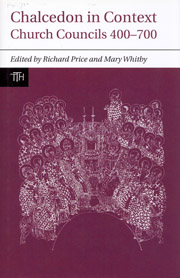Book contents
- Frontmatter
- Contents
- Abbreviations
- List of Contributors
- Introduction
- The Council of Chalcedon and the Definition of Christian Tradition
- ‘Reading’ the First Council of Ephesus (431)
- The Syriac Acts of the Second Council of Ephesus (449)
- The Council of Chalcedon (451): A Narrative
- Truth, Omission, and Fiction in the Acts of Chalcedon
- Why Did the Syrians reject the Council of Chalcedon?
- The Second Council of Constantinople (553) and the Malleable Past
- The Lateran Council of 649 as an Ecumenical Council
- The Quinisext Council (692) as a Continuation of Chalcedon
- Acclamations at the Council of Chalcedon
- An Unholy Crew? Bishops Behaving Badly at Church Councils
- Index
The Council of Chalcedon (451): A Narrative
- Frontmatter
- Contents
- Abbreviations
- List of Contributors
- Introduction
- The Council of Chalcedon and the Definition of Christian Tradition
- ‘Reading’ the First Council of Ephesus (431)
- The Syriac Acts of the Second Council of Ephesus (449)
- The Council of Chalcedon (451): A Narrative
- Truth, Omission, and Fiction in the Acts of Chalcedon
- Why Did the Syrians reject the Council of Chalcedon?
- The Second Council of Constantinople (553) and the Malleable Past
- The Lateran Council of 649 as an Ecumenical Council
- The Quinisext Council (692) as a Continuation of Chalcedon
- Acclamations at the Council of Chalcedon
- An Unholy Crew? Bishops Behaving Badly at Church Councils
- Index
Summary
Before the Council
The conventional opening date for the Christological controversy of the fifth century of which the climax was the Council of Chalcedon is the arrival at Constantinople in 428 of its new archbishop, Nestorius, a Syrian monk, who publicly criticized the ascription to the Virgin Mary of the title Theotokos (Mother of God). The issue was not the status of the Virgin but the question who it was who was born of her – a human being, united to the Godhead but yet distinct from it (as Nestorius supposed), or God the Word himself, who, in the words of St Paul, ‘being in the form of God, thought it not robbery to be equal with God, but emptied himself, taking the form of a servant, being born in the likeness of men.’ Opposition to Nestorius was led by Archbishop Cyril of Alexandria, who spotted the opportunity to humiliate the upstart see of Constantinople but was also genuinely shocked by Nestorius' stance – not out of any special devotion to the Virgin, but because of his own emphasis on God the Word made flesh as the one personal subject in Christ and as the one to whom we are united in holy communion. The controversy led to the condemnation of Nestorius at the First Council of Ephesus (431), which was wildly popular in Ephesus itself (after the vote Cyril was escorted to his lodgings by women swinging thuribles) but deeply resented in Syria.
- Type
- Chapter
- Information
- Chalcedon in ContextChurch Councils 400-700, pp. 70 - 91Publisher: Liverpool University PressPrint publication year: 2011



